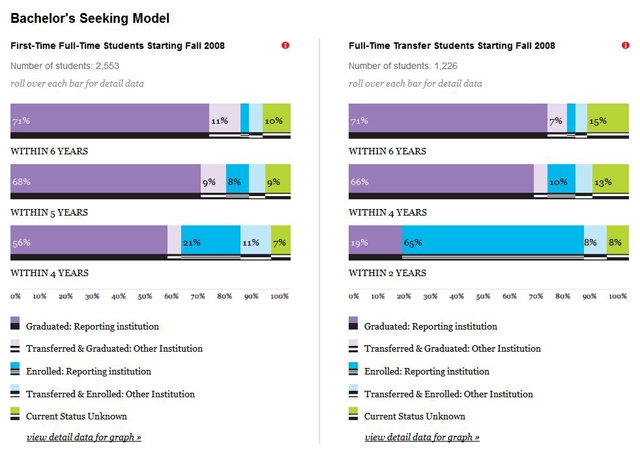 Click the image to view DePaul's SAM profile and data.
Click the image to view DePaul's SAM profile and data.
DePaul recently joined nearly 600 higher education institutions across the nation in a project known as the
Student Achievement Measure, or SAM. SAM is an alternative to the federal graduation rate and is a more accurate representation of outcomes for students seeking associate and bachelor’s degrees.
In a market of complex ranking systems and myriad tools to measure student outcomes and institutional effectiveness, SAM introduces a student-centric method of reporting graduation rates. It realistically reflects how a large percentage of today’s undergraduates—both at DePaul and nationwide—pursue higher education by including outcomes for students who transfer between institutions.
SAM v. Federal Graduation Rate
The federal methodology for calculating an institution’s bachelor’s degree graduation rate measures the percentage of first-time, full-time, degree-seeking students (or, “traditional freshmen”) who graduate within four to six years.
However, according to research from the National Student Clearinghouse (the organization that generates data reported in SAM), more than 20 percent of students who complete a degree do so at a different institution than where they started. Yet as soon as they transfer from their original institution, they disappear from the federal calculation whether or not they graduate.
The federal methodology, developed out of the Student Athlete Right-to-Know Act in 1988, tends to reflect better on institutions serving mostly traditional-aged undergraduates on a residential campus, while underrepresenting institutions like DePaul that serve a more diverse group of learners such as transfer, adult and commuter students.
SAM provides a needed alternative methodology that reports more outcomes for more students, including transfers, those who are still pursuing their degree at the end of six years (either at the home institution or a transfer college or university), and students whose current enrollment or graduation status is unknown.
DePaul’s SAM Graduation Rates
SAM models outcomes for the two largest groups of bachelor’s degree-seeking students at DePaul:
- first-time, full-time freshmen who started at the university
- full-time students who transferred into the university
DePaul’s six-year graduation rate for the fall 2008 cohort of first-time, full-time freshman students is 71 percent. However, when accounting for students who transferred and graduated from another institution by 2014, this rate grows to 82 percent. Put another way, an additional 11 percent of DePaul’s fall 2008 cohort graduated from another institution within six years. This presents a more comprehensive, student-centered view of the performance of the entire freshman cohort—not just those who graduated from DePaul.
DePaul’s Success in Graduating Transfer Students
Accounting for students who transferred into the institution is essential for accurately reporting DePaul’s graduation statistics. “Nearly half of the students who received their bachelor’s degree from DePaul last year transferred here from another institution,” says Liz Sanders, assistant vice president for EMM’s Institutional Research and Market Analytics (IRMA), the department coordinating DePaul’s participation in SAM.
“The SAM methodology lets us showcase transfer completion rates and tell a more complete story about college completion; both are important for DePaul,” says Sanders.
Seventy-one percent of full-time transfers from the 2008 cohort graduated from DePaul within six years. An additional 7 percent graduated from another institution within the same timeframe.
Click
here to view DePaul’s profile and data. For more information about the methodology used, click
here.
Growing participation in SAM in Illinois and across the U.S.
Participation in SAM has grown to nearly 600 community colleges and four-year institutions in just over two years, and the list continues to expand. Thirteen two- and four-year institutions across Illinois are currently contributing to SAM. DePaul and Northwestern are the only private, four-year institutions represented in Illinois.
SAM is funded in large part by the Gates Foundation and the Carnegie Corporation, and is endorsed by six higher education associations that represent accredited, nonprofit public and private institutions at the two- and four-year level.
For more information about DePaul’s participation in SAM, contact
Liz Holder, research associate for IRMA.